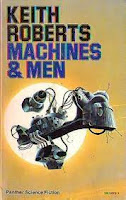Few contemporary science fiction readers know the name Keith Roberts. Which is a shame. When the history of the genre is written, his name is worthy of the pantheon. Evolving from H.G. Wells rather than Burroughs or Verne, Roberts always begins with the human element before extrapolating in subtly imaginative fashion a tweak to society, technology, environment, and other areas critical to the human experience. While not exemplary of precisely why Roberts is worthy of the pantheon, Machines & Men (1973), Roberts' debut collection, nevertheless shows where it all began.
Consisting mostly of novelette-length stories, Machines & Men is divided into two halves. You guessed it. Kicking off “Machines” and the collection is “Manipulation”. I have a dislike of tele-anything—telepathy, telekinesis, etc. (except teleology). “Maniulation” has them all. Thankfully, Roberts grounds this story of one man and one particular crush he has in psychological reality. More anti-hero than superhero, Roberts questions the use to which a person would put such abilities—when you know that you know that you know, but can do something about it, which is interesting.
Unique for Roberts, “”Escapism” puts aside the gravitas the reader could be accustomed to in his oeuvre and replaces it with a light-heartenedness, a sense of fun. It’s somewhat ironic then, that the idea of mashing film reality with reality comes off as a bit forced. Escapism, indeed. About sci-fi poltergeists, “Boulter’s Canaries” continues in the cinema vein, telling of a pair film hobbyists who set up a homemade camera at some minor city ruins one night. The results unexpected, they soon find themselves as curious as the cat… A straightforward story that waffles a bit getting to its climax—but the climax pays off.
One of those so sublimely evil stories you don’t know it’s evil until the trickle of ramifications has become a waterfall, “Sub Lim” is about a down on its luck film company that looks to a new technology in its darkest hour. While the results are initially positive for the owners, matters eventually catch up to them. “Breakdown” starts at a rural English mechanic’s garage, but ends up in more uncanny territory. Fixing cars is fixing cars until it’s something less finite and predictable. Another interesting psychological presentation.
“Therapy 2000” kicks off the “Men” half of Machines & Men. A piece of writing that needed to be novel length to see its themes and ambition fully realized, this story of a man undergoing therapy is a slow way to start the second half. Picking things up and making for one of the best stories in the collection is “The Deeps”. Presenting what would become 'classic Roberts', its worldbuilding slowly gives way to characters whose lives are intertwined with what makes the imagined world still human. About a mother and teen daughter in an underwater city, youth, it seems, always outpaces their patents, leaving the mother a lot to reflect on in their eerie, dark, silent world.
A classic science fiction premise (Are synthetic humans human?), “Synth” takes the premise to its logical conclusion by featuring the trial of a synthetic human. A courtroom drama, Roberts replaces his normally dense prose for a much lighter affair in getting to the heart (ha-ha) of existence. The conclusion, however, does give the story a touch if weight—gravitas, as it were. And closing “Men” and the collection is “The Face That Kills”. A story that feels like a lark, like an idea written on a bet, tn this future Britain the fear of car accidents has become a political tool. Drivers vs Peds are the ruling powers, and in the story a rogue gang of drivers attempt to stay out of sight of John Law. A bit of bad luck and… I kept hoping for the satirical shoe to drop, but the moralized ending seemed to confirm that Roberts was attempting to take the story seriously - at least as seriously as a lost bet allows.
In the end, recommending Machines & Men is simple. For two types of reader in particular. First are fans of Roberts, people who know the subtle strength and literary qualities of his writing. They may not find that in every story here, but it's at least good to understand where it all started—how he emerged from the writing womb. The second are fans of more nuanced, human-oriented science fiction. This is not sensawunda, shooty-shooty bang-bang. There are aliens, there is otherworldliness, the uncanny reveals itself, and some alternate realities/societies are explored. But people remain the core material.


No comments:
Post a Comment